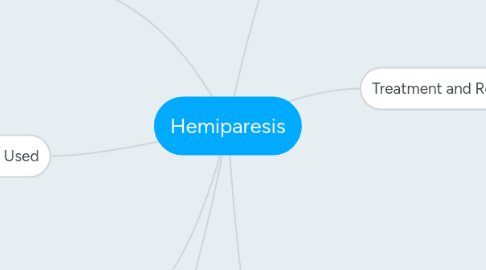Hemiparesis
Thayan Kathirchelvanにより


1. Causes
1.1. Brain Disorder
1.2. Stroke
1.3. Head Injury
1.4. Cerebral Palsy
1.5. Brain Injury
1.6. Meningitis
2. Forms Of Hemiparesis
2.1. Left sided Hemiparesis: Involves the right side of the body and the brain, which controls someone's learning process and behaviour types
2.2. Right sided Hemiparesis: Involves the left side of the body and the brain to be affected, which controls speaking and language
2.3. Pure Motor Hemiparesis: Most common type of hemiparesis. Affects one half of the body including face, arms and legs. Some parts may be more affected than others
3. Technologies Used
3.1. Braces/Prosthetics
3.2. Big walking machines
3.3. Robotics
3.4. Excercise machines
4. Symptoms
4.1. Difficulty to walk
4.2. Problems in balance
4.3. Difficulty in swallowing
4.4. Trouble with vision
4.5. Numbness
4.6. Feelings of depression
4.7. Very poor memory
5. Treatment and Rehabilitation
5.1. Physiatrists: Doctors specializing in rehabilitation and controls the rehabilitation process of people who have undergone a stroke
5.2. Physical Therapists: Doctors specializing in treating disabilities regardeing movement, and help to improve endurance and strength
5.3. Occupational Therapists: Assisting in physical and daily activities in regards to the patients. They help with assisting the patient in every day activities
5.4. Electrical Stimulation: Involves the use of small electrical pads that send electrical charges to the body. This helps with movement of arm
5.5. Cortical Stimulation: The use of electrical stimulation in the part of the brain called the "cortex". This is said that it helps with arm and hand movement
5.6. Motor Imagery (MI): A mental practice procedure that involves the patients visualizing them moving their limbs, which in turn helps the patient with movement
6. Possible Ideas
6.1. An arm brace/ leg brace with rollers with soft comforting rollers
6.1.1. Uses an app to control the frequency and the speed of the massager
6.1.2. An outer covering with holes to prevent sweating or excess perspiration build up
6.1.3. An internal padding to make both products comfortable on the inside
6.1.4. The outside to be made out of a waterproof material to be used in recreational activities like swimming

